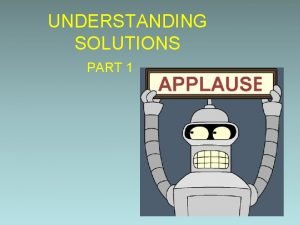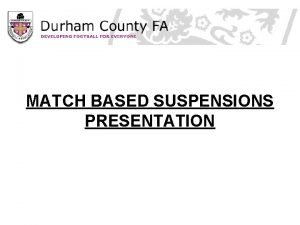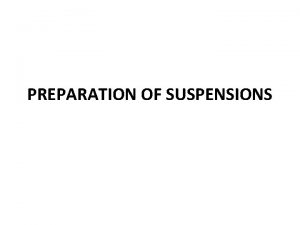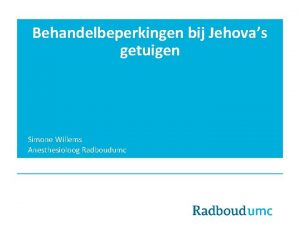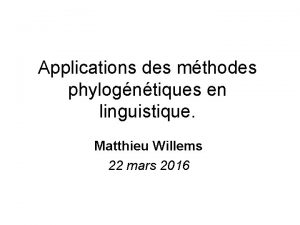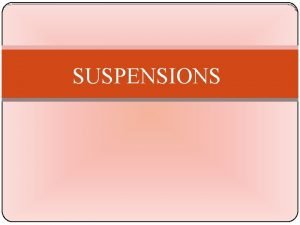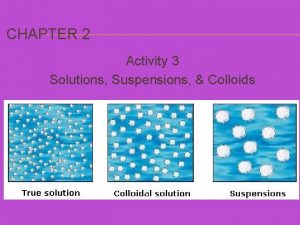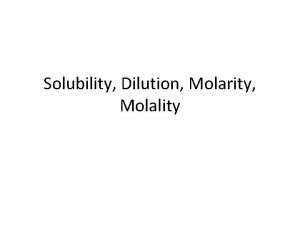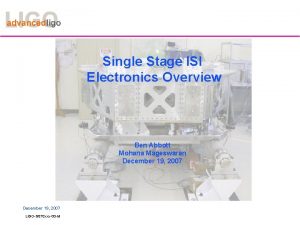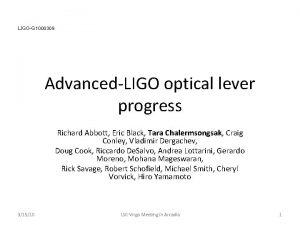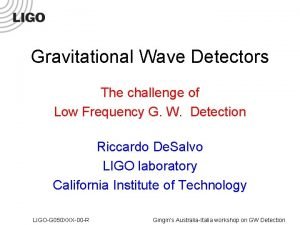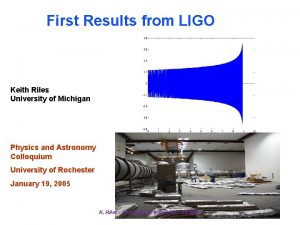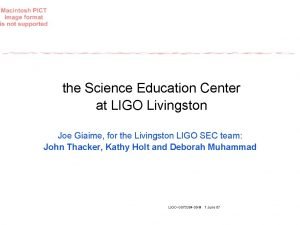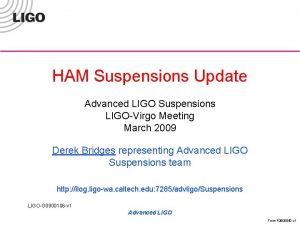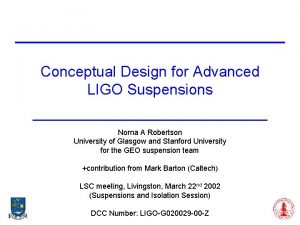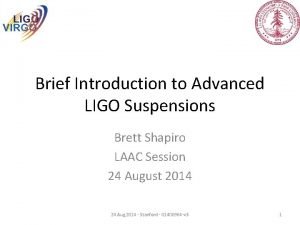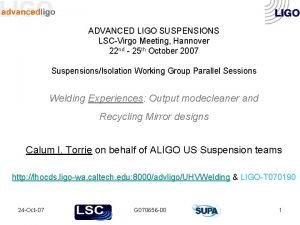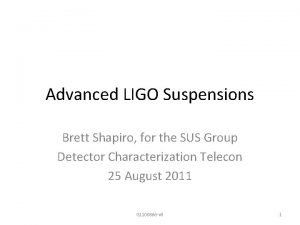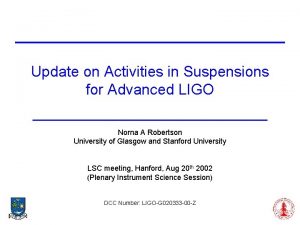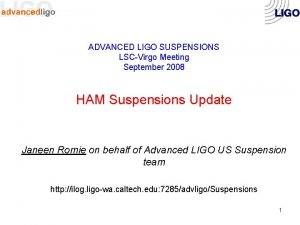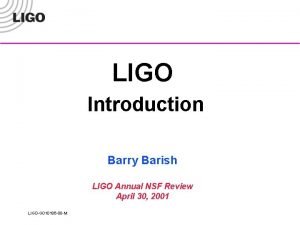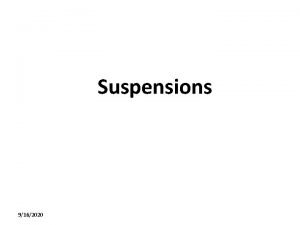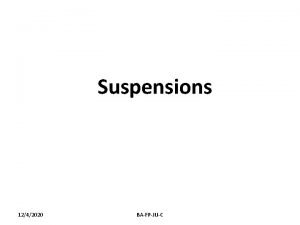Suspensions Design for Advanced LIGO Phil Willems NSF













- Slides: 13

Suspensions Design for Advanced LIGO Phil Willems NSF Review, Oct. 23 -25, 2002 MIT LIGO-G 020501 -00 -D LIGO Laboratory

Recent Progress: Suspension Prototyping Mode cleaner triple pendulum: (3. 5 kg ‘silica’ mirror, all magnetic actuation, no reaction mass chain) to be installed in LASTI Jan. 2003 Test mass quadruple pendulum (30 kg ‘sapphire’ mirror, reaction mass chain for quiet actuation) LIGO-G 020501 -00 -D LIGO Laboratory 2

Recent Progress: Blade Springs unstressed blade l Deviations from ideal blade compliance complicate suspension design in many ways: » Total deflection of ~10 cm must be precise to ~1 mm to match interface tolerances of actuators, beam centering, etc. » Some suspension modes are sensitive to precise distance from blade tips to center of gravity of mass l Several solutions now in use stressed blade » Build a large inventory of blades, select best samples » Trim total blade deflection by trimming masses below » Trim blade tip position with angled clamps LIGO-G 020501 -00 -D LIGO Laboratory 3

Recent Progress: Eddy Current Damping Eddy current damping has been used by TAMA, and is now demonstrated at Glasgow. Measured strength is adequate for damping of triple suspensions, but less than desired for quads. LIGO-G 020501 -00 -D LIGO Laboratory 4

Recent Progress: Fibers and Ribbons l l Silica ribbons made in Glasgow have up to 2. 9 GPa tensile strength, far above 760 MPa working stress. Fibers can have both low thermal noise and low bounce frequency with a suitable diameter profile (the ‘dumbbell’ fiber), giving us another option to meet suspension thermal noise specs. Strengths are also high. measured dumbbell fiber strengths l LIGO-G 020501 -00 -D Fiber Q’s over 4 x 108 have now been measured. LIGO Laboratory 5

Low-Frequency Cutoff l l Early in 2002, the impact of the lower cutoff frequency for Advanced LIGO’s astrophysical sensitivity, given the constraints of a 10 Hz cutoff on the suspension design. (most notably, penultimate mass density) Conclusions written in LIGO technical memo T 020034: in brief, » Vertical mode frequency: 12 Hz or lower » Horizontal thermal noise: 10 -19 m/sqrt(Hz) or lower » Fundamental violin mode frequency: 400 Hz or higher l Result: both fibers and ribbons remain feasible, penultimate masses can be less exotic. LIGO-G 020501 -00 -D LIGO Laboratory 6

Design “Crossroads” to Come l Downselect: Sapphire vs. Fused Silica Test Masses » Was planned for 2002, now projected to spring 2003 due to long lead time in acquiring prototype sapphire optics l Ribbon vs. Fiber Suspensions » Downselect originally planned for last year, now pushed into the far future because impact of choice elsewhere in design is minimal given option of dumbbell fibers and 12 Hz cutoff l Style of Penultimate Mass » Decision to allow increase of vertical bounce frequency allows lighter penultimate masses, but choice must still be made. LIGO-G 020501 -00 -D LIGO Laboratory 7

Issues: Local Damping l Eddy current damping as tested not as strong as desired for heavier quadruple pendulum suspensions. Shadow sensors are too noisy (10 -10 m/sqrt(Hz), need less than 10 -13 m/sqrt(Hz)). Solutions being considered: » Stronger eddy current dampers- perhaps cryogenic, perhaps superconducting- under consideration at Glasgow » Quieter interferometric position sensors- being tested at Caltech » Two-stage damping: large range & noisy for acquisition, then short range & quiet for operation » Relaxed damping specifications LIGO-G 020501 -00 -D LIGO Laboratory prototype interferometric sensor 8

Issues: Magnetic Noise Sensitivity l Ad. LIGO suspension environment likely to have more magnetic field fluctuations: » Active seismic isolation » Possible electromagnetic preisolation l l Use of voice coil actuation must account for this Measurements of SEI magnetic noise planned for the very near term LIGO-G 020501 -00 -D LIGO Laboratory 9

Issues: Physical Constraints l Larger optics, longer suspensions means less room inside the vacuum tanks » Problem hardest for recycling mirrors- 26 cm diameter but only ~90 cm of headroom proposed recycling mirror suspension l Heavier optics, multiple suspensions means more weight to support » Problem hardest for ITM and FM for folded interferometer » We have an 800 kg mass constraint from SEI LIGO-G 020501 -00 -D LIGO Laboratory 10

Issues: Creep and Excess Noise l l l Noise of nonthermal origin is known to exist, but is poorly quantified Measurements of fiber excess noise at Syracuse and Moscow are ongoing Other sources (e. g. from the mirror or coating or bonded ear attachment) still unknown, though the TNI, GEO 600, and LIGO itself can eventually quantify these. Fiber creep measurement at Perugia Silicate bond thermal creep measured at Caltech 22°C LIGO-G 020501 -00 -D 90°C 120°C LIGO Laboratory 90°C 22°C 11

GEO 600 as Advanced LIGO Prototype l Because the Advanced LIGO suspension is based upon the GEO 600 design, GEO 600 itself will provide a wealth of data and experience in the use of such suspensions. Results to date have been very promising, with the suspensions being robust and controllable with a very high (>97%) locked duty cycle. LIGO-G 020501 -00 -D LIGO Laboratory 12

Suspensions Development Plan l l l PPARC proposal for UK contribution of quadruple pendulum suspensions (test masses, beamsplitters, folding mirrors) LIGO Lab will contribute triple pendulum suspensions (mode cleaners, recycling mirrors) Samples of each class to be tested in LASTI through two design phases starting in Jan. 2003 LIGO-G 020501 -00 -D LIGO Laboratory 13
